The Polar Vortex has just returned for the cold season 2021/2022, yet it is already facing its first stratospheric warming event. An unusually early warming event is starting over the Polar regions, with more warming forecast to follow into the late month.
The Polar Vortex is without a doubt one of the key factors for the weather during the cold season. It is strongly connected all the way from the ground up into the stratosphere. Every strong change or disruption of the Polar Vortex can have a profound effect on the weather development, so we take great notice of the activity high above in the stratosphere.
Before explaining what is coming for the Polar Vortex and our weather, we will quickly learn what exactly is the Polar Vortex and this stratospheric warming. We try to explain this in most of our winter articles, as knowledge is essential and powerful, so why not learn something new in just mere seconds.
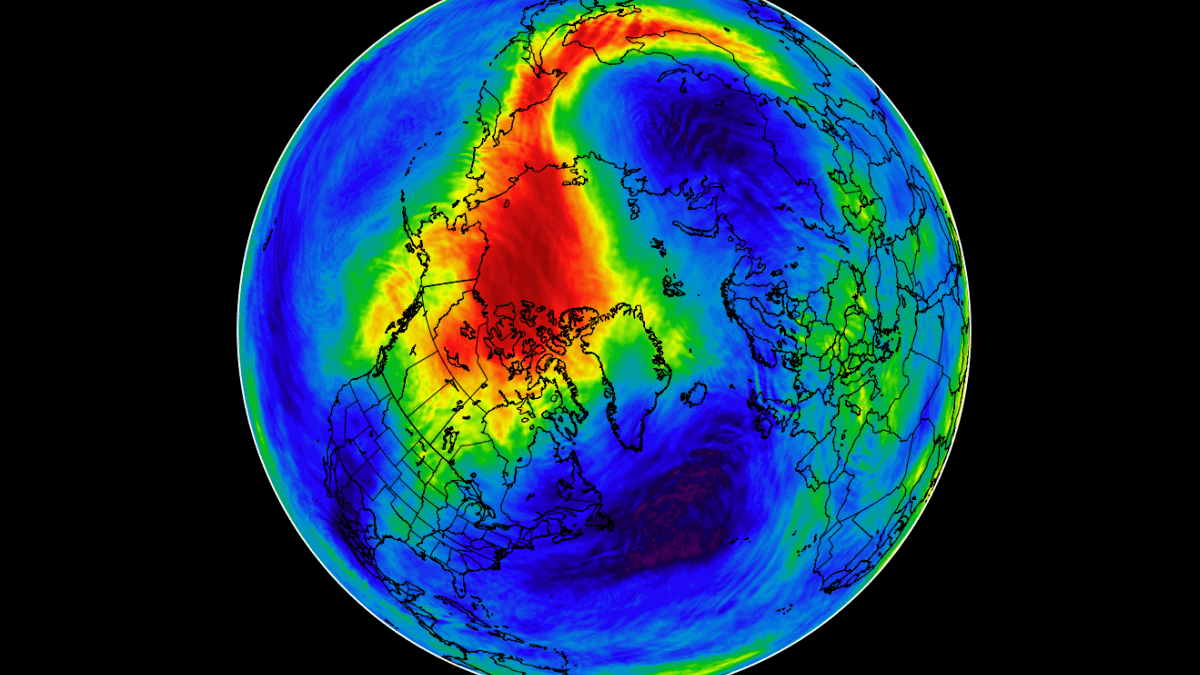
SPINNING OVER THE NORTH
All of the clouds (and our weather) are found in the lowest layer of the atmosphere called the troposphere. It reaches up to around 8 km (5 miles) altitude over the polar regions and up to around 14-16 km (9-10 miles) over the tropics.
Above it, there is a much deeper layer called the stratosphere. This layer is around 30 km thick and is very dry. This is where the famous Ozone layer resides. You can see the layers of the atmosphere on the image below, with the troposphere on the bottom and the Stratosphere with the ozone layer above it.

These layers are important, because when you hear people talk about the polar vortex and its influence, in most cases they mean the higher altitude stratospheric part. While the stratospheric polar vortex is spinning high above our weather (but being strongly connected and influential), the lower tropospheric polar vortex actually IS our weather.
Every year as we head into autumn, the north pole starts to cool down. But the atmosphere further south is still relatively warm as it continues to receive energy from the Sun, while the polar regions receive much less over time. You can see the winter solstice below, as the polar regions receive little to zero solar energy.

As the temperature drops over the polar regions, so does the pressure. In the stratosphere, the process is the same. As the temperature drops over the pole and the temperature difference towards the south increases, a large low-pressure (cyclonic) circulation start to develop across the polar stratosphere.
The image below shows a typical example of the Polar Vortex at around 30km/18.5miles altitude (10mb level) near the top of the stratosphere during the cold season.

It is basically like a very large cyclone, covering the whole north pole, down to the mid-latitudes. It is strongly present at all levels, from the ground up, but in different shapes.
The next image below will show you the polar vortex at much lower down, at around 5km/3miles altitude. It reveals the true shape and size of the polar vortex closer to the ground (cold colors). The closer to the ground we get, the more deformed the polar vortex gets, because of the growing influence from the terrain and the many weather fronts and systems.
Be aware of its “arms” extending into the lower latitudes, also bringing along colder air into the region.

For an even better idea, we produced a high-resolution video for you below, which very nicely shows the Polar Vortex spinning over the Northern Hemisphere at around 30km/18.5miles altitude. This is in the stratospheric layer.
Video shows December 2020 to January 2021 period, made from NASA GEOS-5 data. We used the potential vorticity parameter, which (simplified) means that it shows the energy of the polar vortex. Notice how the polar vortex covers a large part of the Northern Hemisphere, and you can also see the stratospheric “anti-vortex”, as it deformed and attacked the Polar Vortex, spinning in the opposite (clockwise) direction.
The main takeaway from the video should be that the Polar Vortex is not just one single winter storm that moves from the Midwest to the northeastern United States. It is one large cyclonic area that is spinning over the entire Northern Hemisphere, from the ground up to the top of the stratosphere at nearly 50km/31miles altitude.
POLAR VORTEX – COLD SEASON 2021/2022
Usually, we look at the polar vortex in the stratosphere at the 10mb level. That is around 28-32km (17-20 miles) altitude. This altitude is considered to be in the middle of the stratosphere and serves as a good representation of the general dynamics of the polar vortex.
The strength of the polar vortex is most often measured by the power of the winds inside it. Usually, this is done is by measuring the zonal (west to east moving) wind speeds around the polar circle (60°N latitude). Below we have an ensemble forecast for the 10mb winds.
At this time of year, we have a fairly steady cooling trend over the polar regions. This generally means lower pressure and stronger winds. But as you can see on the image, the winds are actually forecast to decrease into the second half of the month. This is not really usual, so we will see what is behind this weakening. The winds pick up later in the month, but the forecast spread is really high.
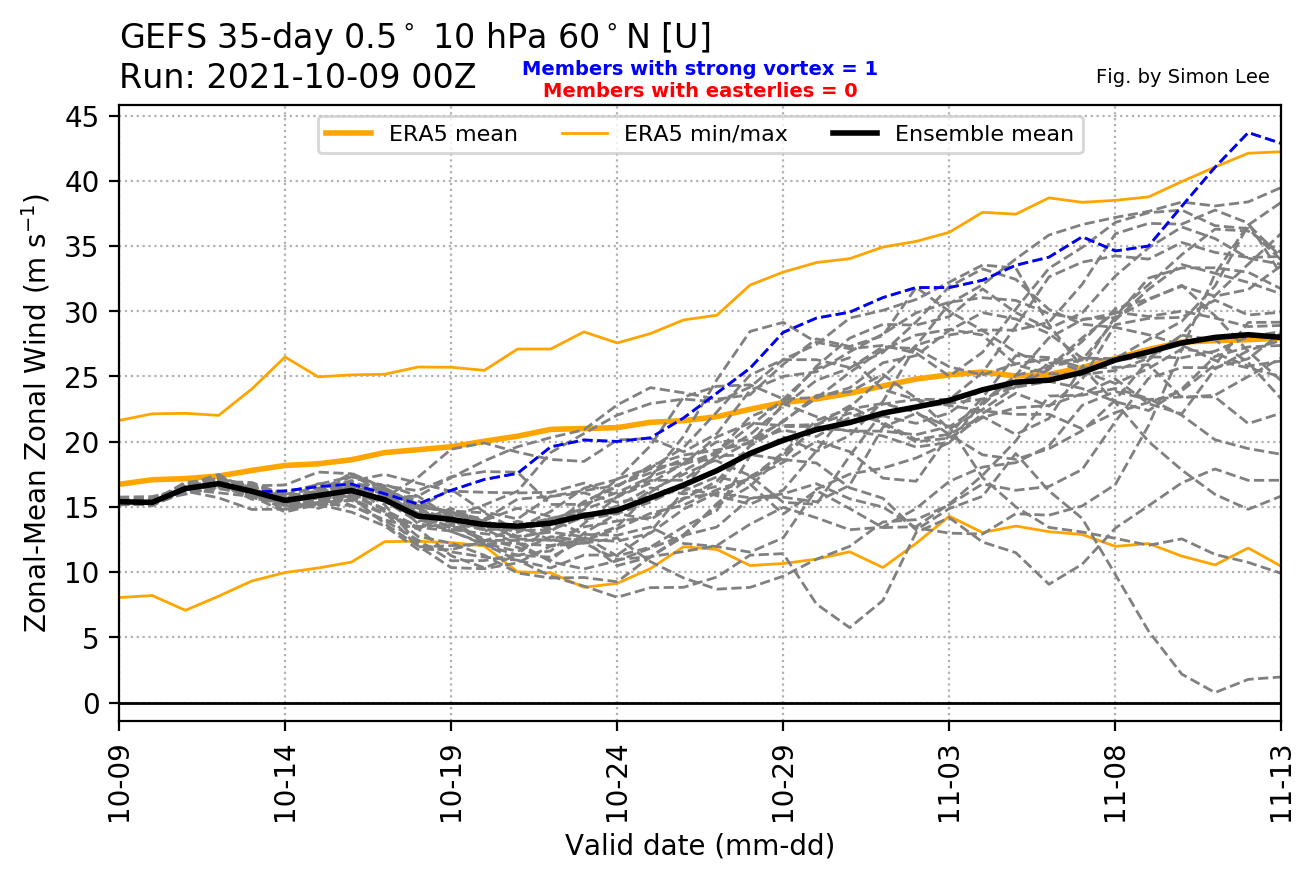
Looking at the pressure anomalies over the polar regions in the past months, we can see an interesting progression. Notice the strong high-pressure buildup in early October. The image also shows pressure anomalies in the vertical. it is obvious that the recent pressure buildup in the polar regions also reached quite high, influencing the middle stratosphere.

These strong weather systems can send energy upwards into the stratosphere, creating all sorts of problems for the polar vortex. The energy transfer tho is not instant, as it has gone through different layers of the atmosphere.
Currently, we can see that the stratospheric polar vortex looks in a good shape. It has the classic circular shape and is perhaps slightly off-center towards Siberia.

The temperature at this level will be normal for this of the year over the Arctic region. But you can see small warming starting over Siberia.

Later this week, this warming is projected to slightly intensify and move further over northeast Siberia. The temperatures might not seem really high, but as we will see on the anomalies, it is quite warmer than normal for this time of the year.

As said, we have the temperature anomaly for this altitude (30km/18.5miles) below. We can see the Siberian region running up to 17 degrees warmer than normal. For this time of the year, this is perhaps a bit unusual, as the earliest warmings usually appear in November.
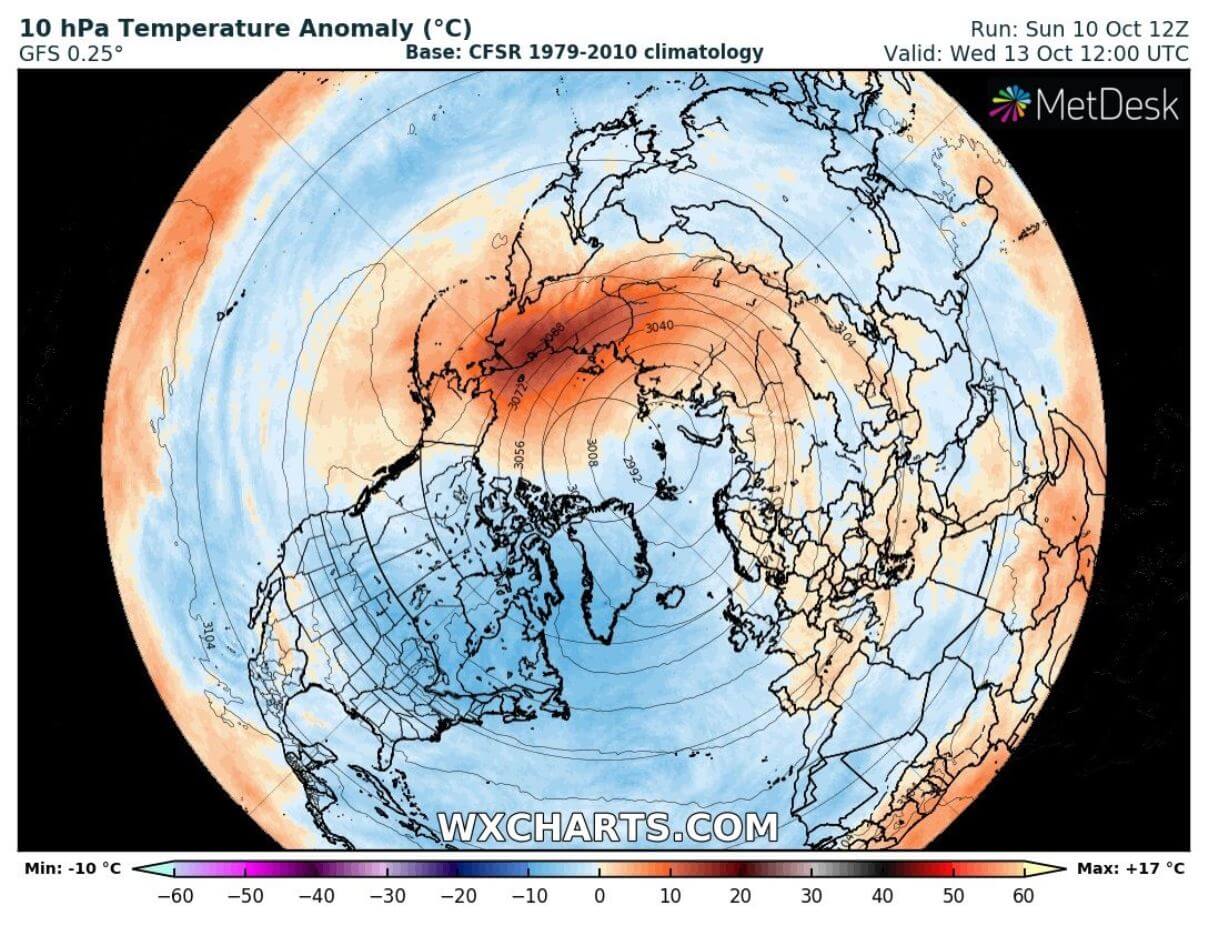
Looking at the state of the polar vortex at this time, we can see it is being pressed against from the Pacific side. We can see a high-pressure area building there, in tandem with the warming wave. But as you will see, another stronger wave is coming soon behind.

In around two weeks, the pressure pattern over the North Pacific is set to amplify. As we can see in the forecast below, we have a strong wave of pressure systems (Rossby Waves) over the North Pacific. This packs a lot of energy and can also send it upwards into the stratosphere.
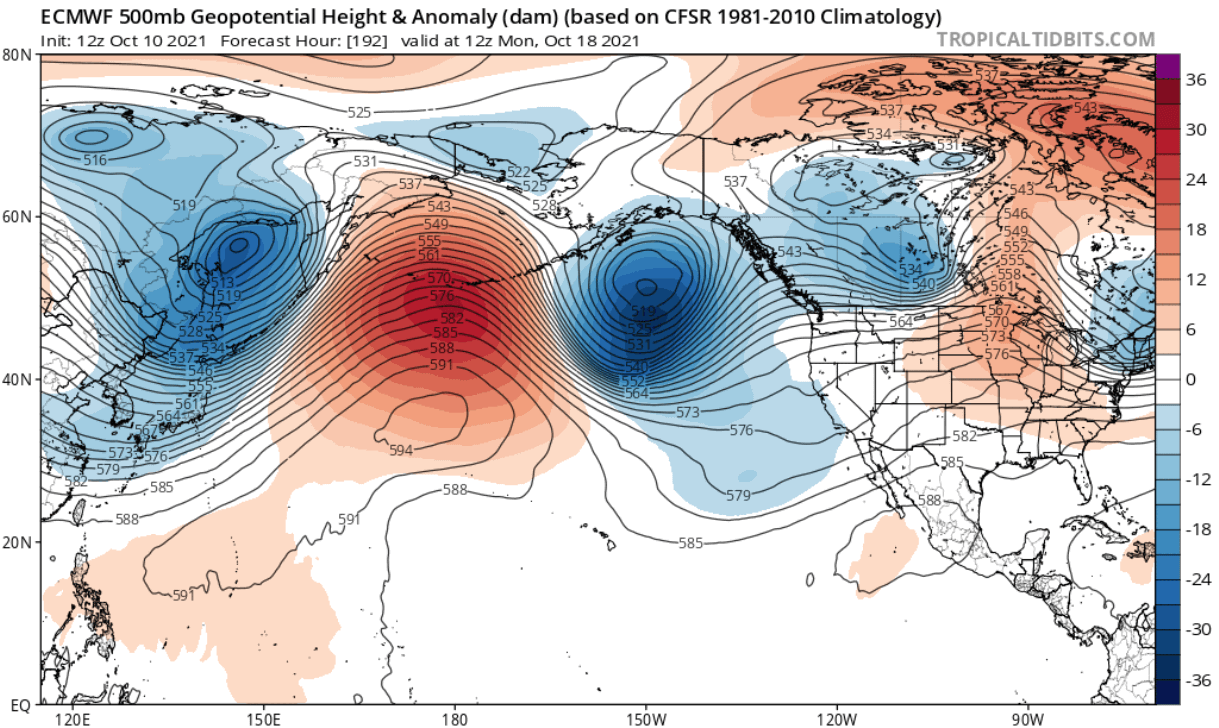
The next map below is special, as it helps us to track the wave activity around the Northern Hemisphere. It basically shows the heat flux on the border between the troposphere and the stratosphere. But the main takeaway is the very obvious strong wave activity over the North Pacific, punching upwards into the stratosphere.

Looking at the state of the polar vortex in the mid-stratosphere, we can see a fairly large high-pressure system over the North Pacific. This is also a result of the strong wave activity over the North Pacific. The polar vortex is being pressed against, changing its shape from the classical circular to more elliptical.
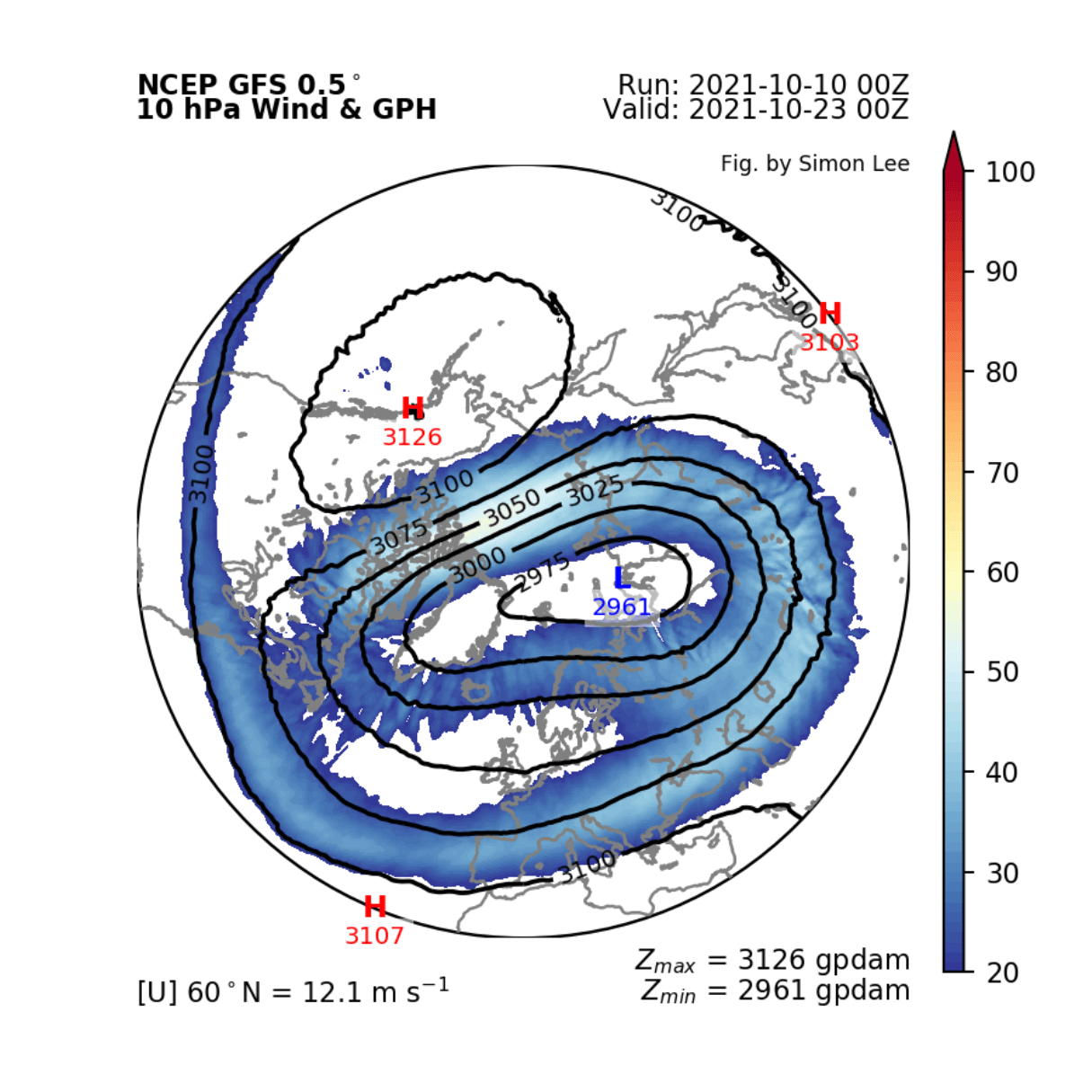
This second warming wave is forecast to come from the Siberian sector. It is forecast to reach further into the polar circle this time. It is featuring warmer temperatures to reach further into the polar circle, raising temperatures up to 18 degrees warmer than normal, but further into the pole.
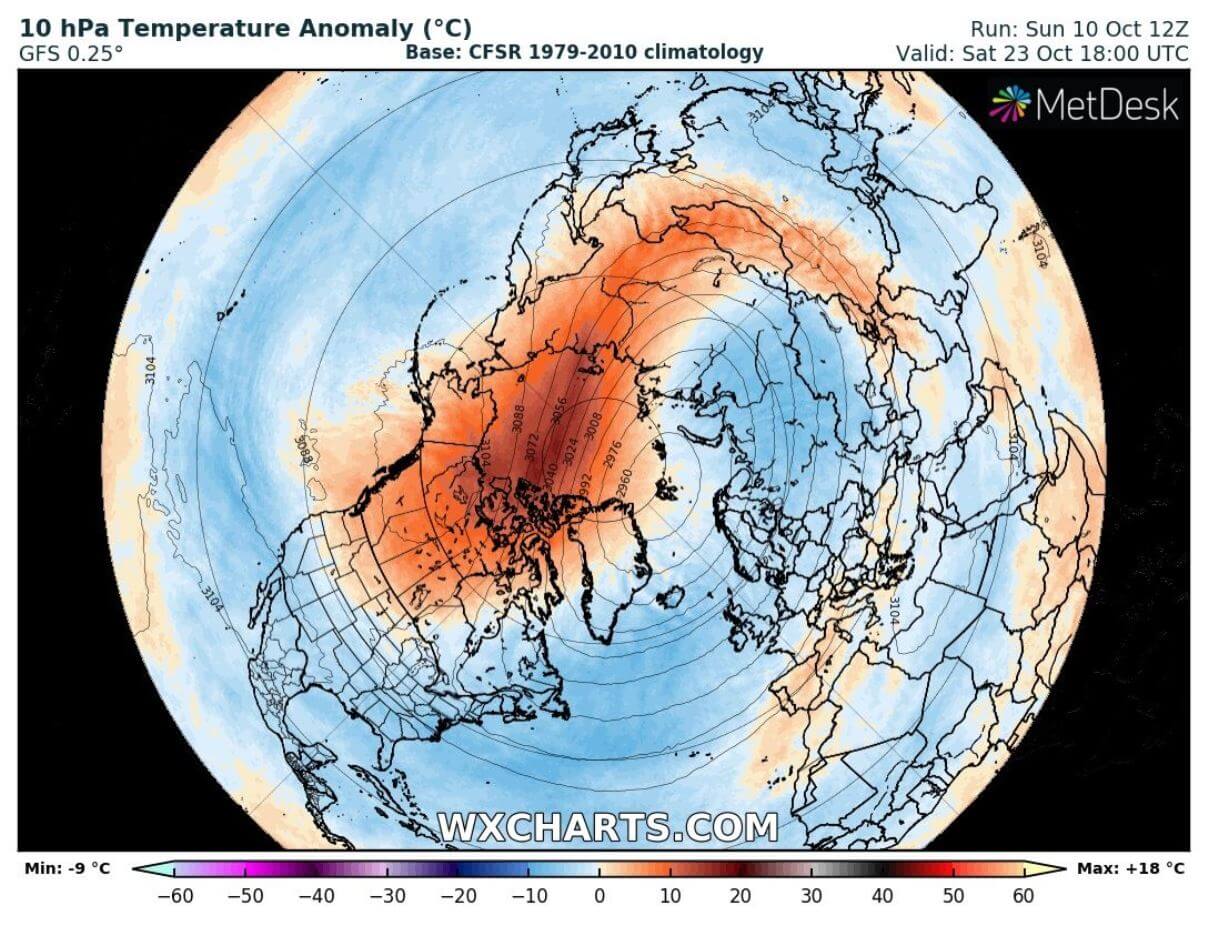
The temperature wave forecast below shows the rising temperatures in the stratosphere this week. We can also see the second wave developing soon after, and staying at a similar level.
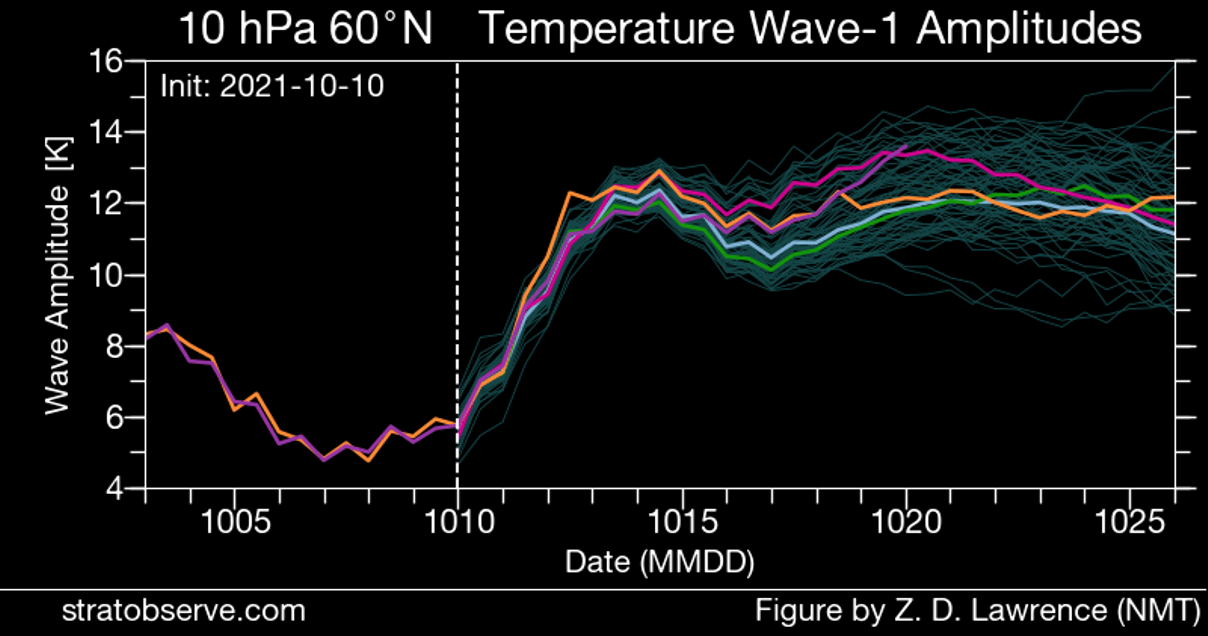
As far as pressure and weather go, there is a special graphic that shows that. On the image below take notice of the high-pressure anomaly rising up from the ground, reaching up into the stratosphere. As a response, we can see the higher pressure anomaly present in the stratosphere, pushing back down. This is just a forecast at the moment but shows the tendency to feedback down the pressure increase.

It is hard to say at this point what (if any) weather effects might be. These stratospheric events and their effects are much more unpredictable than they might seem. The limitation is the model actually getting the surface forecast right, to then being able to add the effects from the stratosphere. At the present time, it is all an unknown, with hints of pressure buildup that is starting to reach down from the stratosphere.
Looking at the extended range forecast from ECMWF, we can actually see trends of new warming waves over Siberia. Below we have an ensemble forecast for mid-November. It shows the temperature anomaly at the 10mb level (30km/18.5miles). The extended forecasts have their limitations, so we are only looking at the trend.
This current trend is definitely a clear sign that the polar vortex will not have it easy at the start of this cold season. We will of course monitor the situation closely, as these are titanic changes that have the power to change the course of Winter 2021/2022 if strong enough.
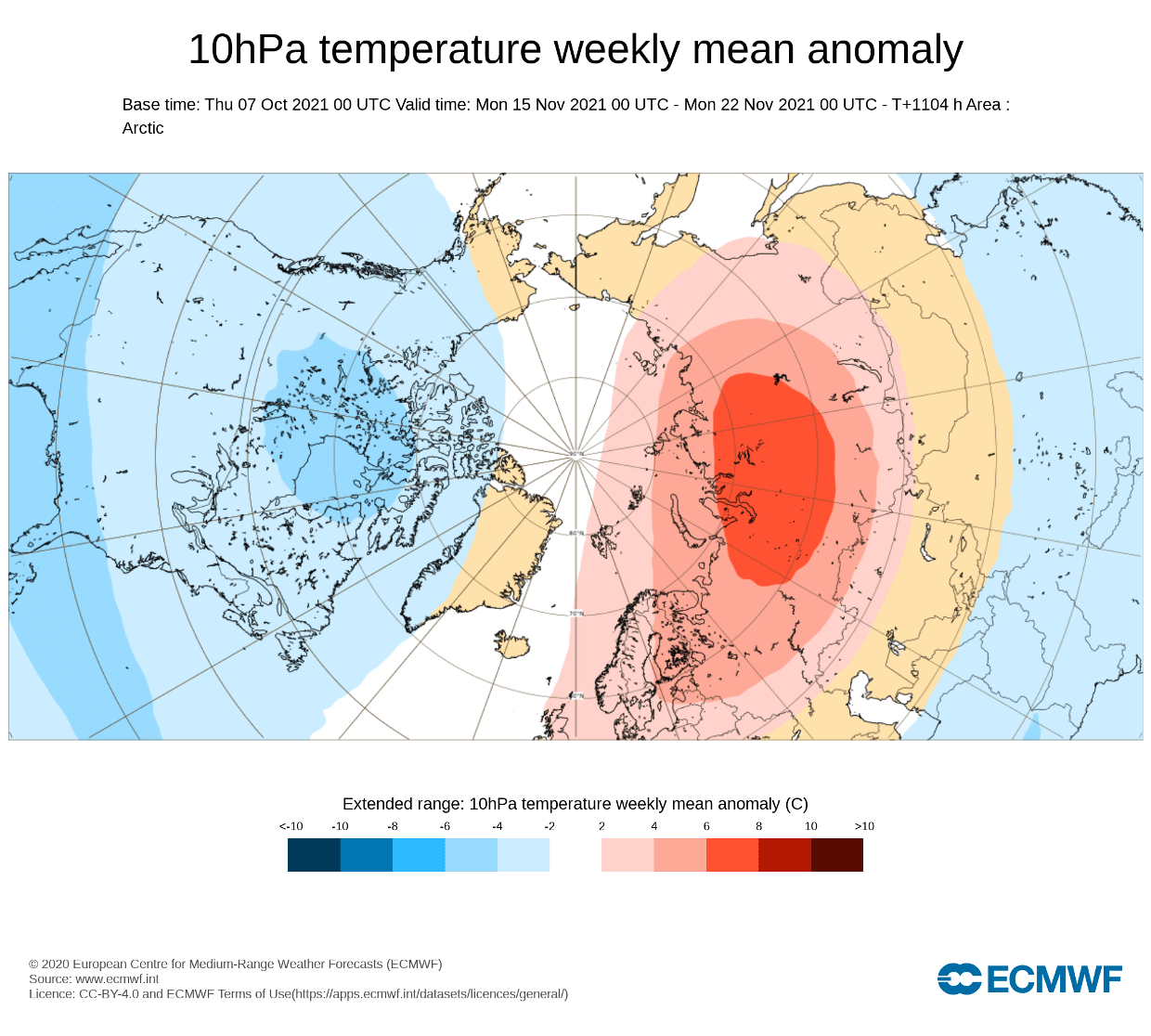
The best example of such an event changing the course of Winter was no further back than last winter. You will see below, how the major stratospheric event unfolded this January, changing the weather patterns across the North Hemisphere in January and February. It was later recognized as the main culprit behind the cold arctic outbreak in the southern United States in late February.
MAJOR STRATOSPHERIC WARMING 2021
Keeping it simple, a Sudden Stratospheric Warming event (SSW) is exactly what the name suggests. It is a sudden temperature rise in the polar stratosphere during the cold season. Warming of the stratosphere means that the polar vortex is weakened, and can also collapse under the pressure from the warming event.
The source of the warming usually comes from the bottom up, as strong weather systems can actually deflect a lot of energy upwards into the stratosphere, disrupting its dynamics.
On the image below you can see the vertical wave propagation during the 2008/2009 cold season. Notice the red areas, which show the energy moving from the low levels up into the stratosphere, disrupting the circulation. This energy is mainly responsible for creating a warming event.
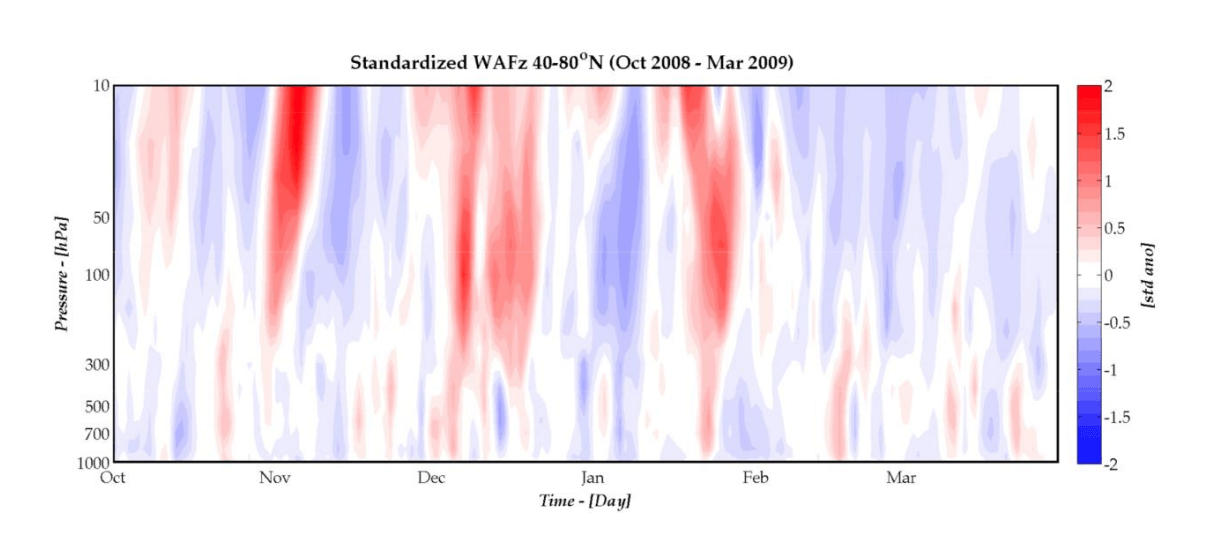
While the current events are categorized as minor warming, we have witnessed major stratospheric warming this year, in early January. It began quite sooner, and it changed the weather patterns for the rest of Winter.
In early December, the polar vortex was at a strong level, reaching over 40m/s (90mph) zonal wind speeds. Towards mid-month, and even more in late December, the polar vortex began to weaken. We can see on the graph below how the zonal wind became negative in early January, due to the breakdown of the polar vortex.

The next images below will show you the temperature at the 10mb level, which is in the middle stratosphere at around 30km/18.5miles altitude. Here, the polar vortex is much more circular in shape, as there is less influence from the terrain and the weather fronts at this high altitude.
Anyhow, in late December, a warming sequence began in the stratosphere, expanding from Europe over into central Asia. It was starting to engulf the outside layers of the polar vortex. The cold-core of the polar vortex was still rather strong at this point, with temperatures colder than -80°C in the center over Greenland.

Just two days later, a strong warming wave reached its peak over Siberia, with maximum temperatures in the wave reaching up to +5°C or higher. In normal conditions, the temperatures here are over 30-40°C lower, so this was a very significant warming wave.

At this time, the actual polar vortex at this altitude (30km/18.5miles) looked more triangular in shape. The image below shows vorticity, or to simplify, the energy of the polar vortex. We can see it was being drained of energy, by a strong (barely visible) anticyclonic system over the North Pacific and the Aleutians.
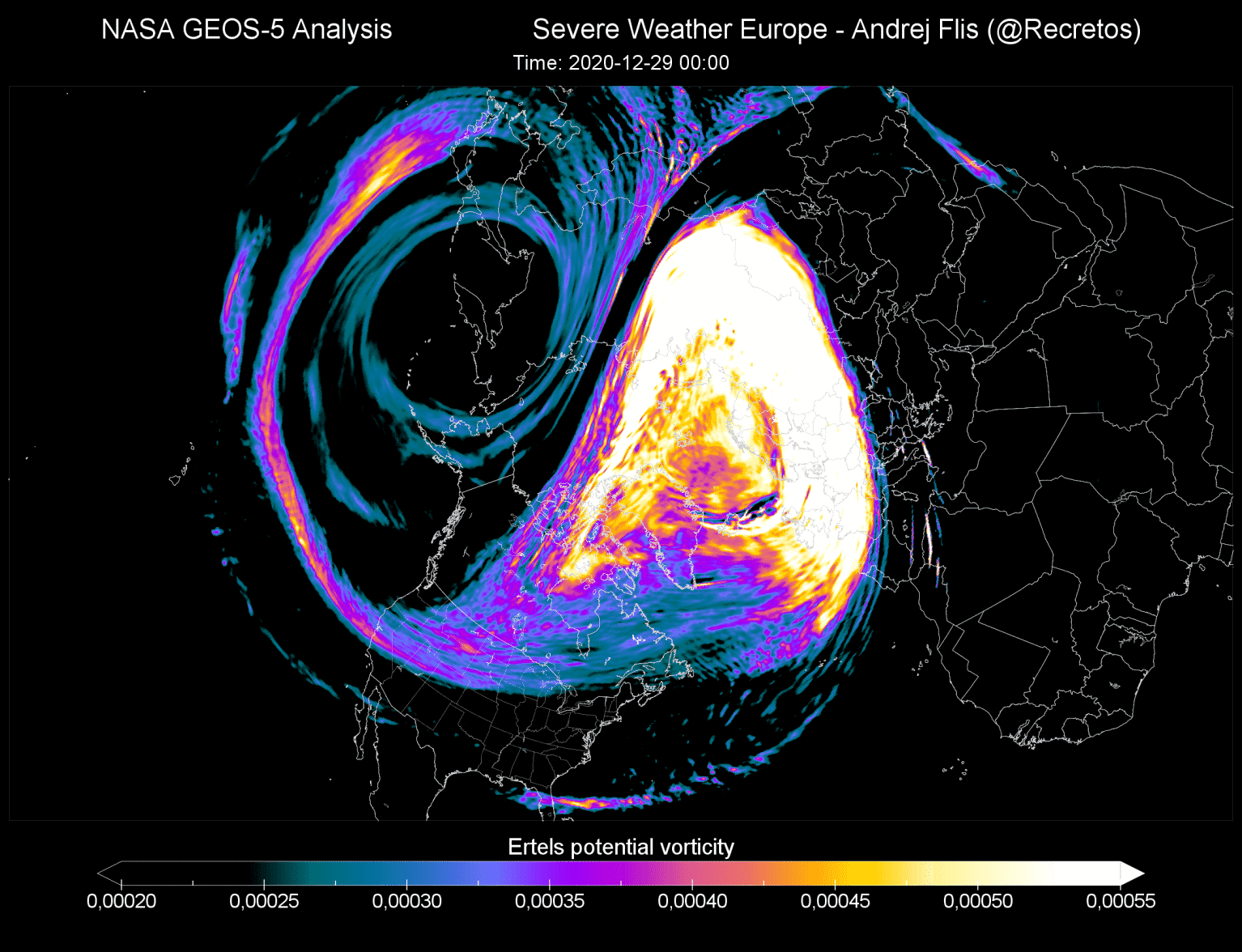
On January 5th, the preliminary date of the Sudden Stratospheric Warming event was marked, as the winds around the polar circle have reversed.
The stratospheric warming wave has moved over the entire North Pole in the stratosphere, effectively splitting the cold-core of the polar vortex into two parts.
One part of the split polar vortex has moved over North America and one over the European sector. At this point, this does not have much to do directly with the winter weather on the surface, as this is at stratospheric altitude. But as you will see, our weather got a good shakeup from this event.

Below we can see the NASA temperature analysis for the polar stratosphere. Notice the large temperature spike at the 10mb (30km) level in early January 2021. This shows a strong warming event, with temperatures continuing to stay above normal into early February.
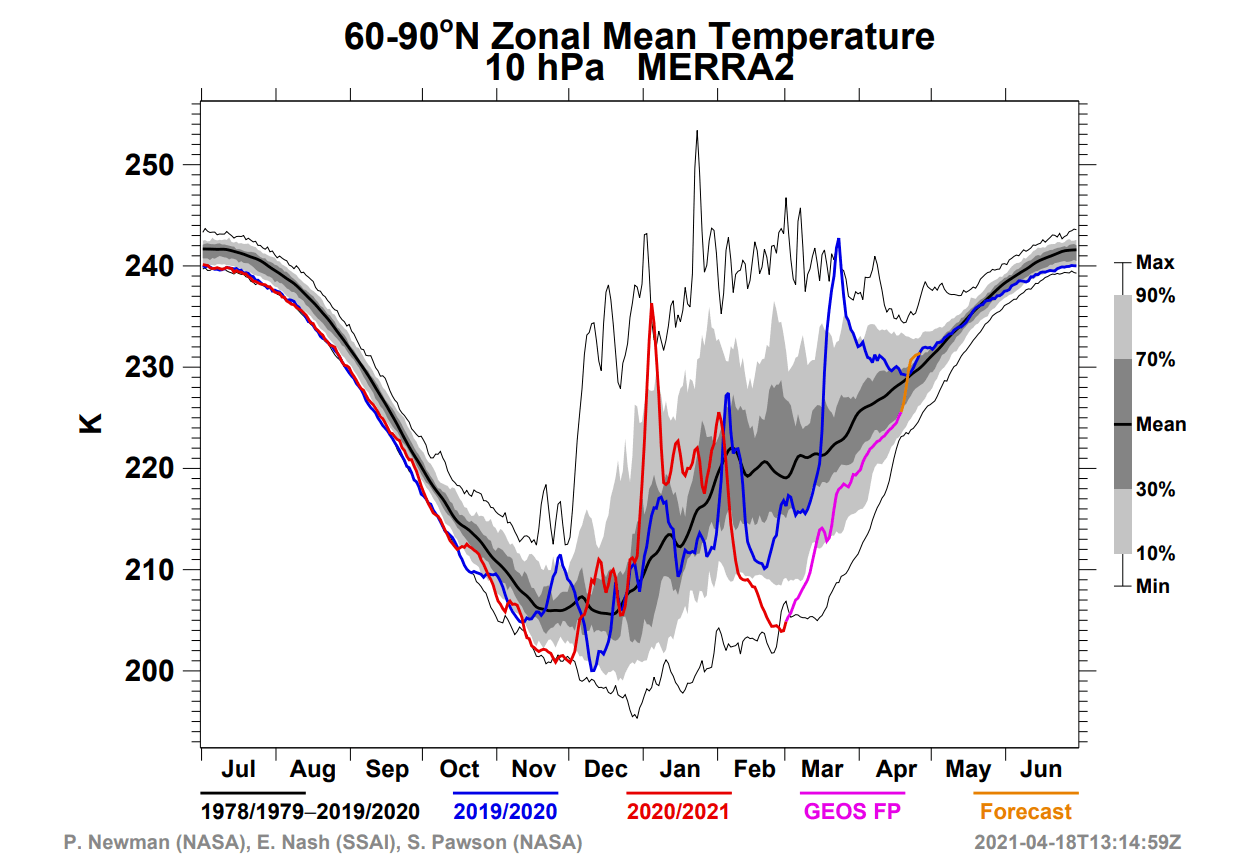
When trying to find a connection between the stratosphere and the winter weather, it helps to have more specialized images at hand. Especially one that combines altitude and time.
The image below shows an atmospheric pressure index. Negative values indicate lower pressure (blue colors) and positive values indicate higher pressure (red colors). We have altitude from the ground up to the middle stratosphere (~30km/18.5miles) in early 2021.
You can see strong positive values in the stratosphere in early January, associated with the pressure rise during the stratospheric warming event. The high-pressure influence was slowly descending over time, reaching the lower levels by mid to late January. This persisted well into February, influencing the weather circulation even when the stratospheric warming was already over.
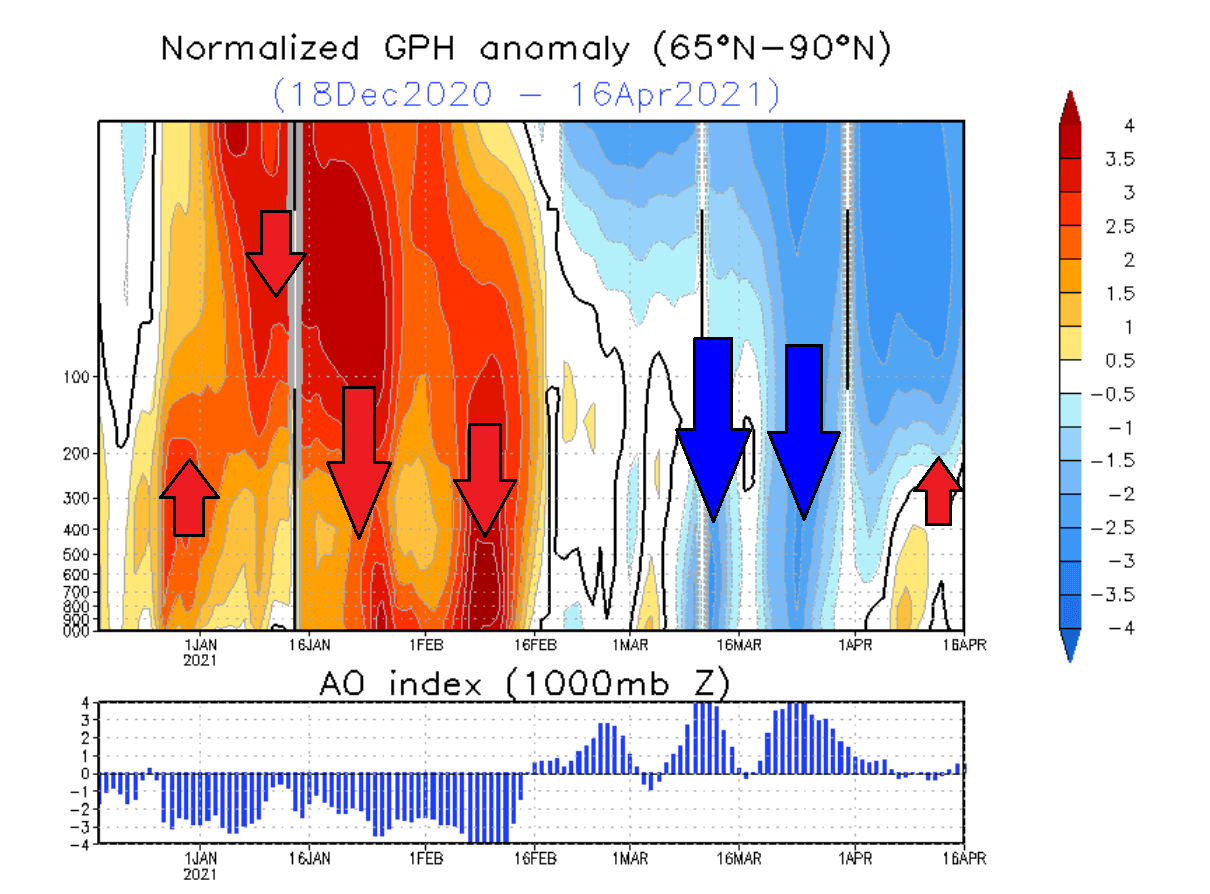
We produced an analysis of the January-February 2021 winter period, showing pressure and temperature anomalies. The first image below shows the pressure anomalies. You can see a strong high-pressure system present over the North Pole. This dominant high-pressure system originated from the stratospheric warming event and the polar vortex collapse, as you can see in the image above.

A strong high-pressure system over the Arctic can heavily disrupt the weather circulation and can unlock the cold air from the Arctic regions towards the mid-latitudes The image below shows the surface temperature anomalies in January-February 2021 period. Warmer than normal temperatures were present under the high-pressure system over the polar regions. Cold Arctic air was pushed out heavily into Siberia, and also into western Canada and the south-central United States.
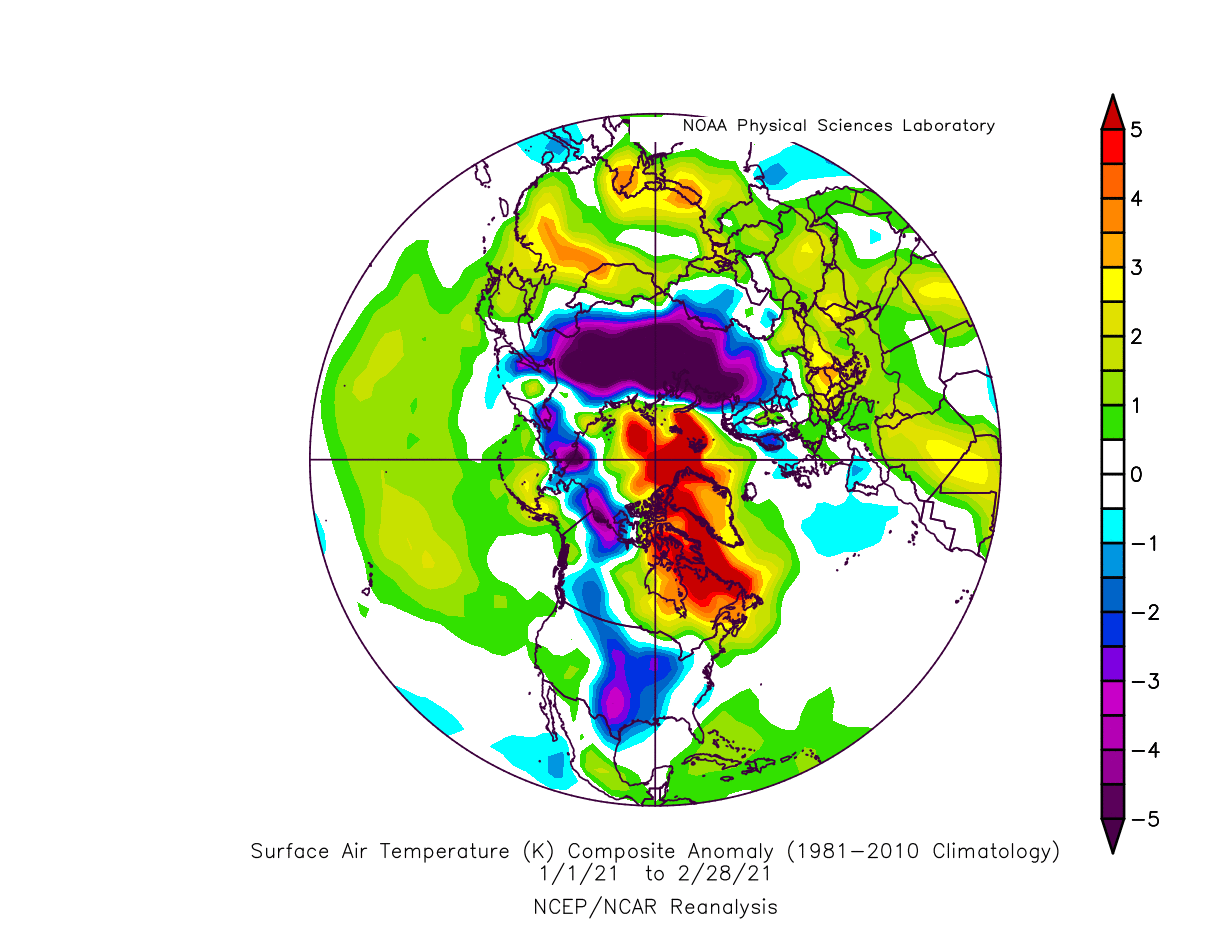
POLAR VORTEX AND WINTER WEATHER
A strong polar vortex usually means strong polar circulation even in the lower levels. It can lock the cold air into the Polar regions, creating milder winters for most of the United States and Europe. A Polar Vortex collapse is just as dynamic as it sounds, as the higher pressure comes crashing down, pushing the cold air out of the polar regions, into the United States and/or Europe.
This creates a chain reaction, which can disrupt the jet stream, creating a high-pressure area over the Arctic circle. That can release the cold arctic air into Europe and the United States. Below we have example images from the great SSW analysis site at ESRL/NOAA, which shows two examples of winters with an SSW event. The winter of 1984/1985 and the winter of 2008/2009.
The top row shows the stratospheric conditions, with warming anomalies, and a polar vortex split into two parts. The bottom row shows the surface temperature anomalies that followed these events, with the very cold winter in 1985 and cooler weather after the 2009 SSW event.
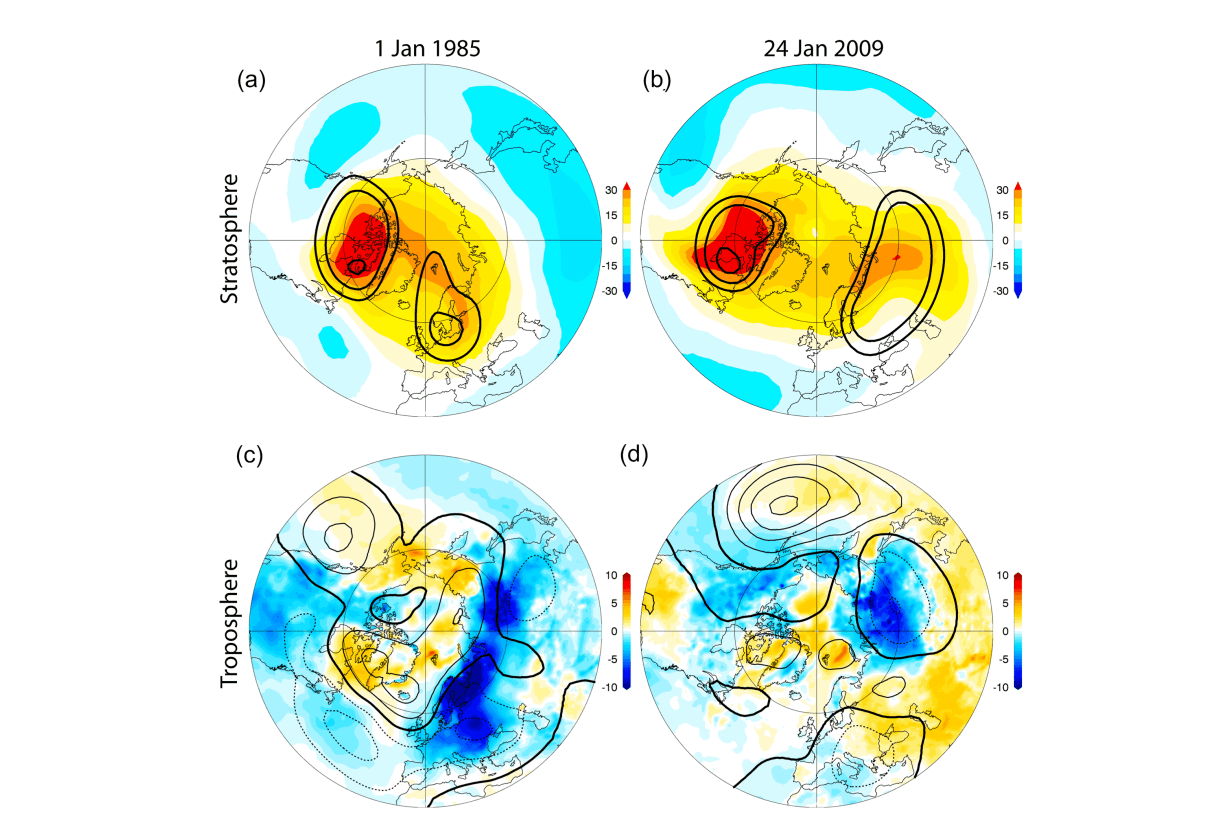
Looking closer at the 1985 warming event, we can see the stratospheric warming (red colors) as it progressed downwards over time. It eventually connected with the surface, raising pressure over the North Pole in mid-January and into February. This event helped to release the colder air into western and central Europe and the northern United States that winter.
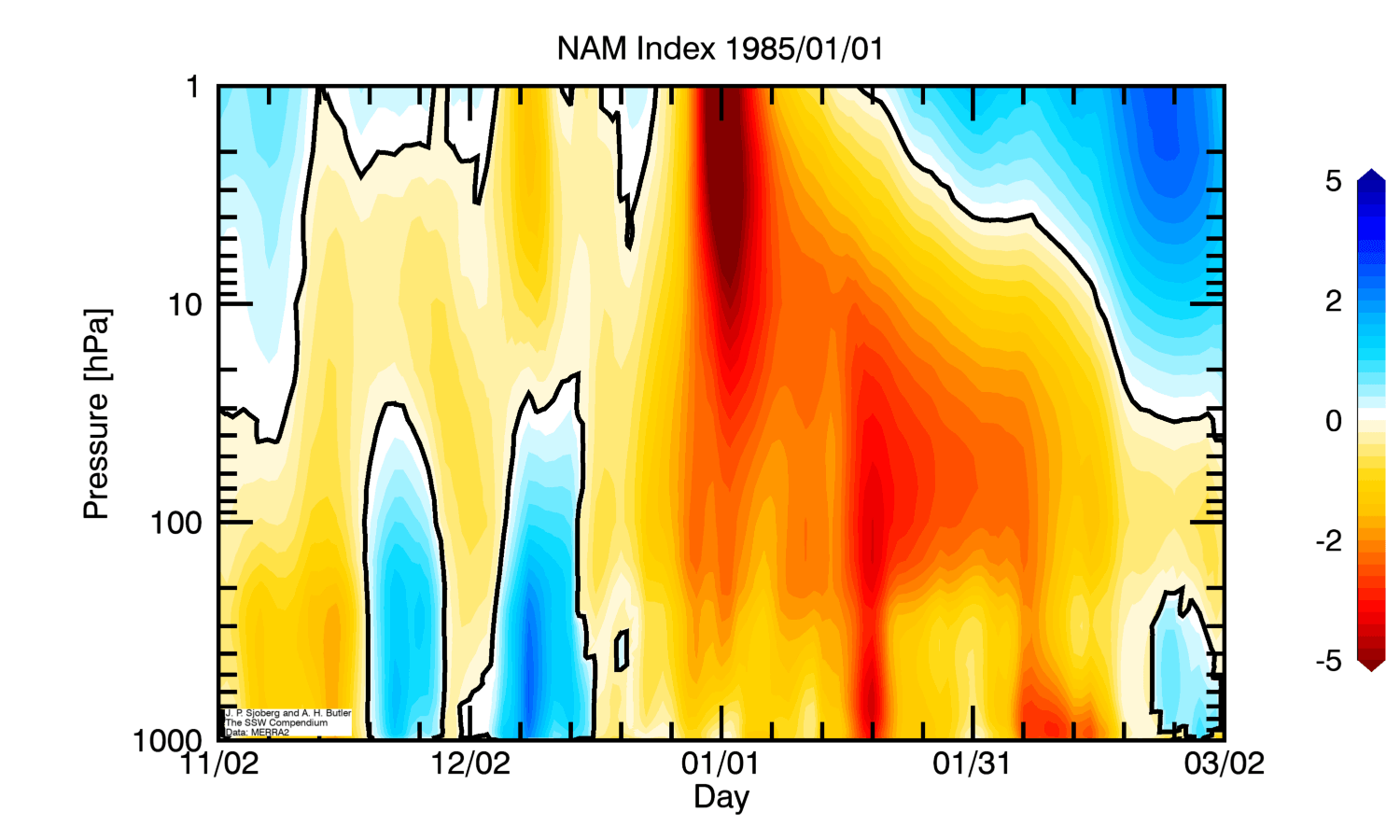
Below we have the surface temperature anomalies, from 0-30 days after the stratospheric warming in 1985. We can see an obvious very cold signal from northern and central Europe and of course much of the United States. The polar regions were warmer than normal, under the strong high-pressure system, generated by the stratospheric warming event.
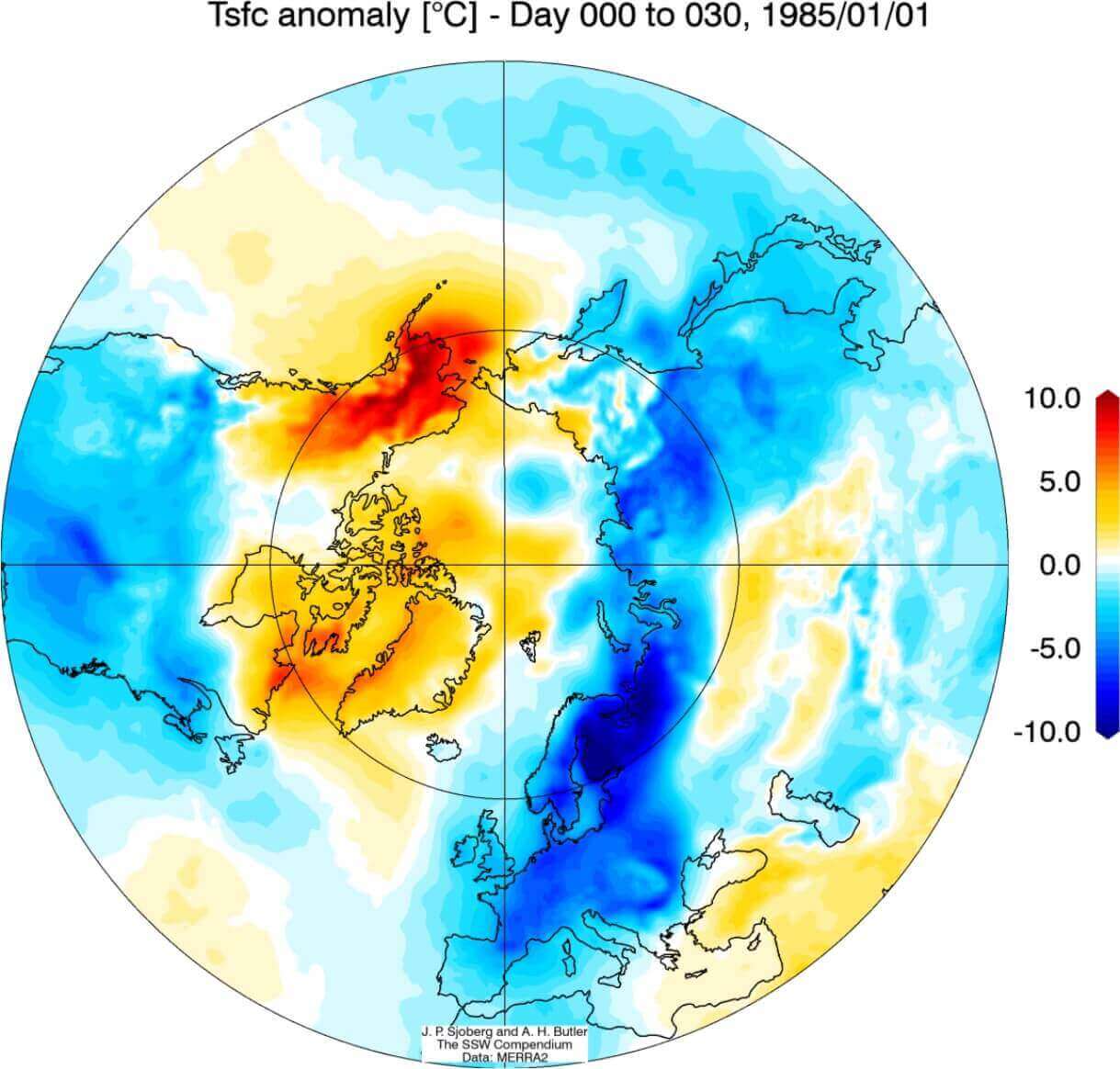
If we combine all Stratospheric Warming events and look at the weather 0-30 days following the stratospheric warming events, we get an interesting picture.
Below we have the corresponding average temperature 0-30 days after an SSW event. Most of the United States is trending colder than normal, and also Europe, with the exception of the southeast parts. Note: this is an average picture of many SSW events. Each individual stratospheric warming event is different and does not automatically mean a strong winter pattern by itself.
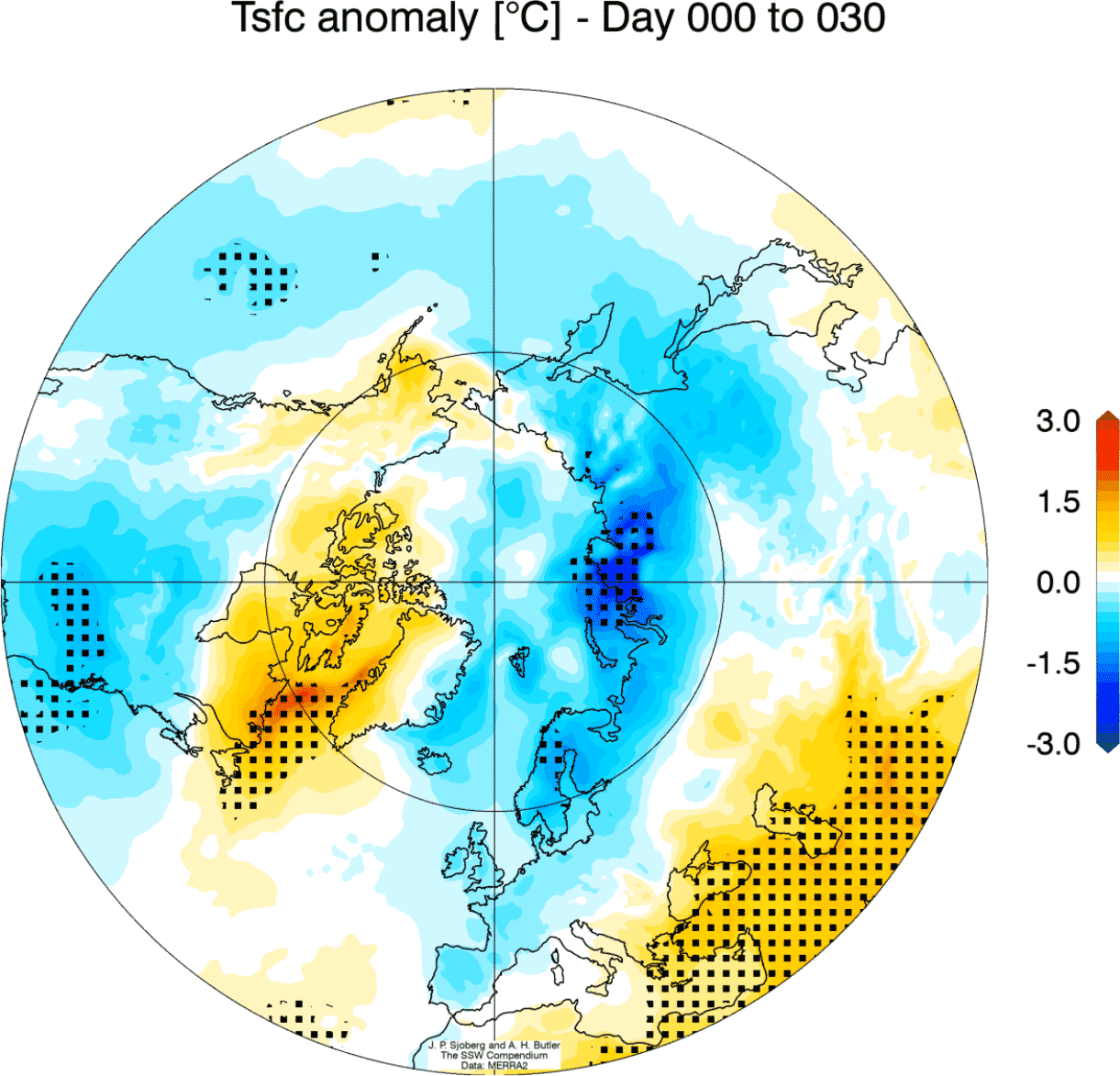
We can see below that the pressure usually rises above the Polar regions, and drops over Europe and the western Atlantic. This is a heavily disrupted circulation, that helps to create a free path for colder polar air to move out of the polar regions.
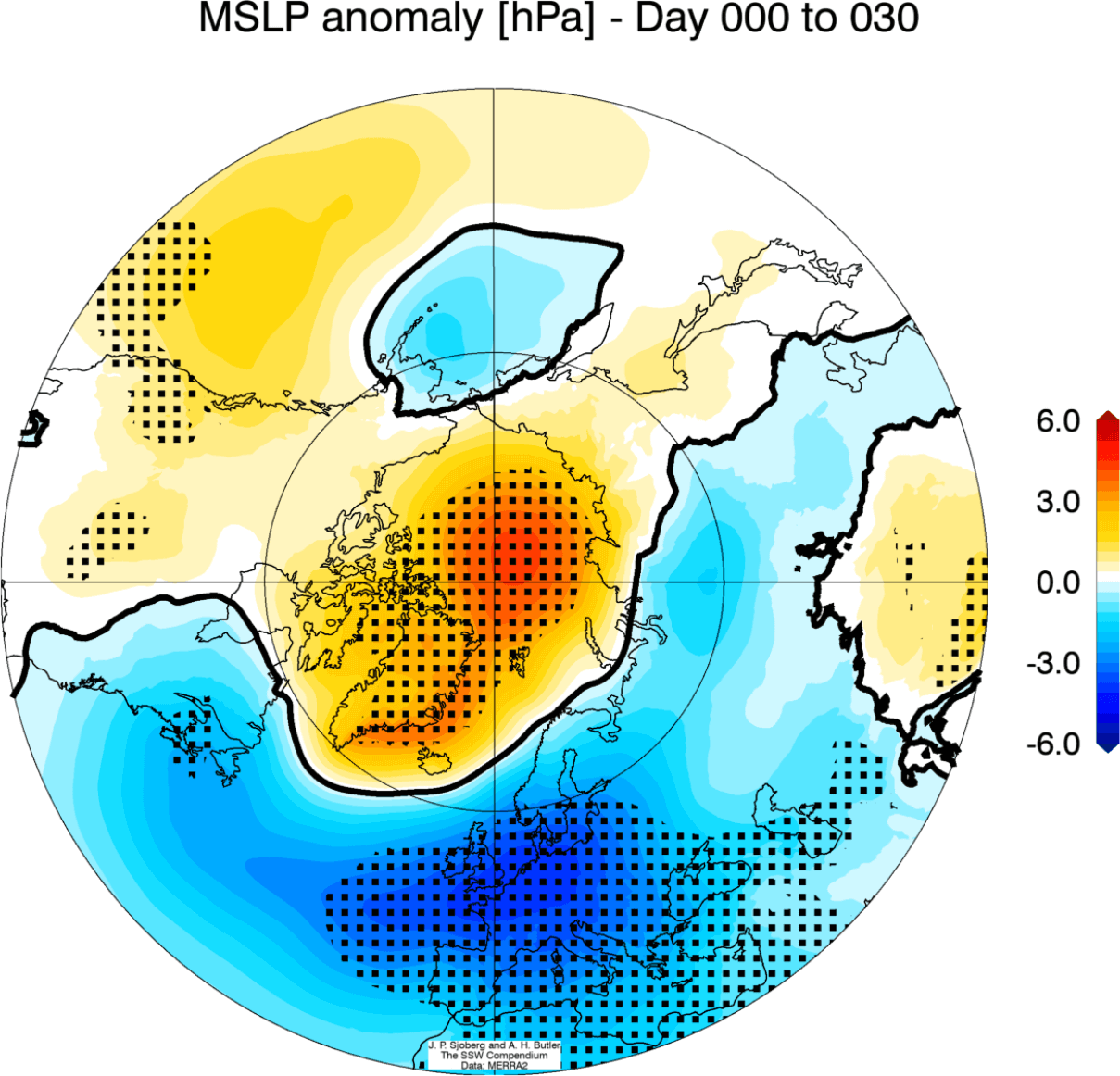
Looking at the snow anomalies below, we can see the above-average snowfall over much of the eastern United States and also Europe. This is a natural response as typically after major stratospheric warming, the colder air has an easier path towards the south and into these regions.

We will release regular weekly and monthly updates for the upcoming cold season as fresh forecasts are produced. So make sure to bookmark our page. Also, if you have seen this article in the Google App (Discover) feed, click the like button (♥) there to see more of our forecasts and our latest articles on weather and nature in general.
SEE ALSO: